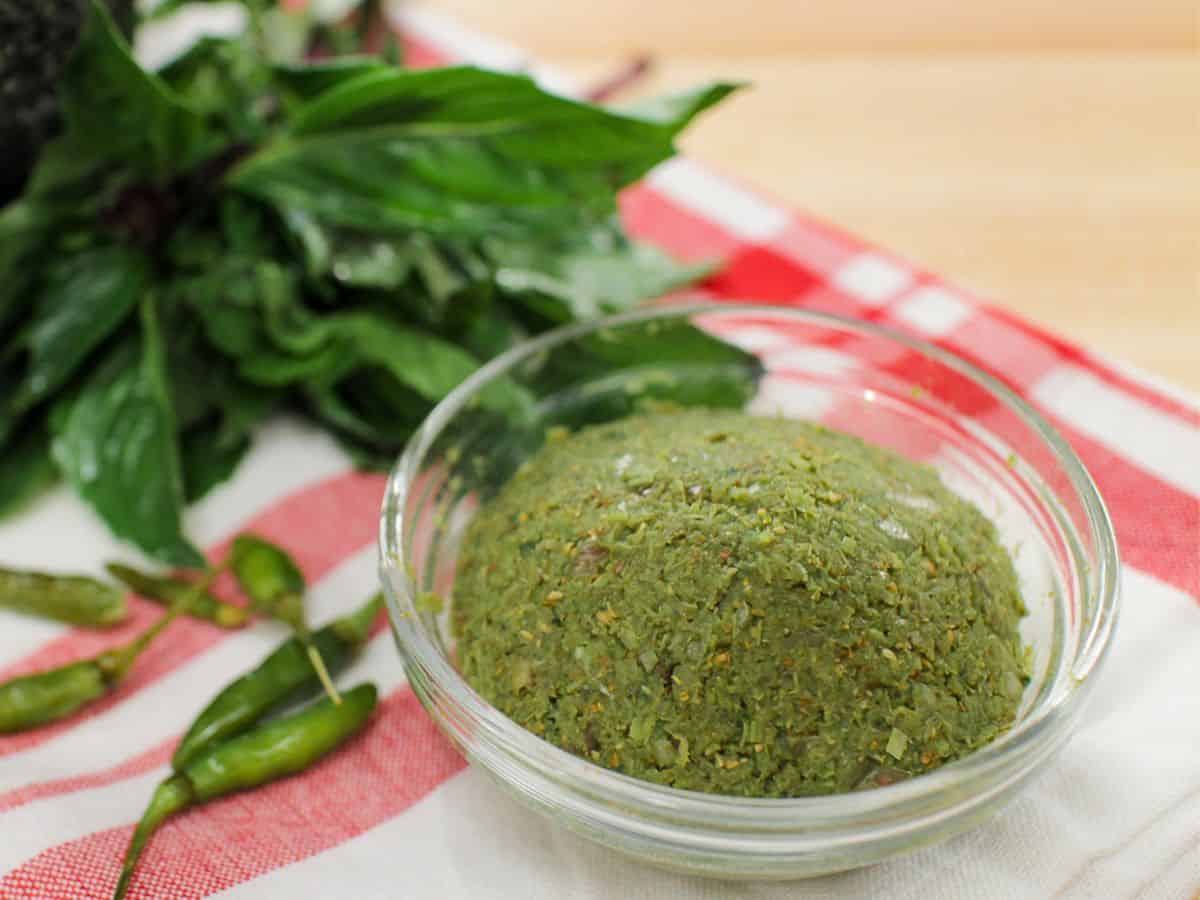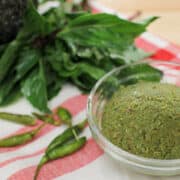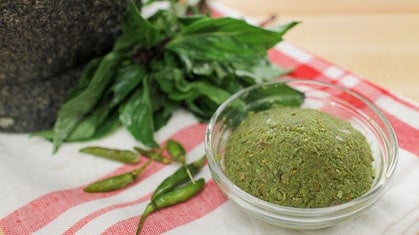Green curry is a classic Thai dish that is a staple in Thai restaurants all over the world. You may have tried making the curry using store bought paste, but perhaps it's time to try making it from scratch? There's nothing like eating a curry that you made with your own homemade paste. Once you're done, try making red curry paste next as many of the ingredients are similar.

What is Green Curry Paste?
Green curry paste is called green curry paste. prik gaeng keow waan in Thai, and it's a paste made from a mixture of herbs and spices, which eventually becomes the base for our famous Thai green curry.
The green colour comes from the use of fresh green chiles, which is unique among most Thai curry pastes which mostly use red dried chilies. These spicy green chiles are also responsible for the distinct fiery flavour of green curry.
Why make curry paste from scratch?
But first, why should you bother making your own Thai green curry paste? There is actually nothing wrong with a good store-bought curry paste, and most Thai people buy the paste premade, too.
So this is something you should do because you want to experience the process and the pride of making something entirely from scratch. It's like making homemade sourdough when you can easily buy one from the bakery down the street.
I will say that it's truly fascinating to see the transformation of the ingredients and the aromas as you go through the process, and it will taste unique, unlike anything else you buy!
Watch The Video Tutorial!
All my recipes come with step-by-step video tutorials with extra tips not mentioned in the blog post, so make sure you watch the video below to ensure success - and if you enjoy the show, check out my YouTube channel!
Ingredients
The biggest hurdle in making any Thai curry pastes is getting all the ingredients you need, particularly the fresh herbs. So locate some good Asian markets in your area that carries a lot of Southeast Asian ingredients, and you can always consult my map of Asian grocery stores to help with that.
- Coriander seeds, toasted
- Cumin seeds, toasted
- White peppercorns
- Thai green chillies or serrano peppers, these are the spicy green chilies that are responsible for the heat of your curry. You can customize the spice level of your paste by adding more or less of these spicy green chilies.
- Milder green chilies such as Korean green peppers or jalapenos. Using both spicy and mild chilies allow us to pack in more chili flavor without too much heat. Korean markets usually have mild green peppers available, and deseeded, de-pithed jalapenos will also work.
- Coarse saltthe coarseness is only helpful in grinding the chilies if you're using a mortar and pestle. Use any salt if using an immersion blender.
- Thai basil leaves, this is added to boost the green colour without adding any more heat from green chilies. Other leafy greens such as spinach will also work, but since you will need Thai basil to make the curry, it's a convenient option. The flavour of the basil will not come through as the paste will be cooked extensively and will cook away most of the Thai basil aroma.
- Lemongrass, for curry paste, do not use dried or powdered lemongrass. Fresh lemongrass is best, but frozen will work. Use only the the bottom half of the lemongrass stalk as it is the most flavourful part.
- Galangal, as with lemongrass, fresh or frozen galangal is best.
- Makrut lime zest (aka kaffir lime zest). You can substitute the zest of half a lime, or if you can find makrut or kaffir lime leaves, you can simply add more of the leaves to the curry itself.
- Cilantro roots or cilantro stems
- Shallots
- Garlic
- Fermented shrimp paste. Called speech in Thai, this is a salty, funky, purplish-grey paste that is also called belacan (Malaysian) or terasi (Indonesian). It is added to most Thai curry pastes for extra umami, but it is not necessary. For vegans, you can also add 1 teaspoon of miso paste or doenjang, or 1 dried shiitake mushrooms, finely grated with a microplane. You can also omit it and then add more fish sauce or soy sauce to the curry itself.
How to Make Green Curry Paste
The following are instructions for making green curry paste using a combination of a coffee grinder and a mortar and pestle. You will need a large, stone mortar and pestle (affl.) for this, not a tiny marble one. If you want to use an electric appliance, see below.
- If your spice tolerance isn't high, remove the seeds and pith from some or all of the spicy chilies (Thai/serranos) to reduce the heat, then finely chop them. If you're not sure how much to remove, I recommend deseeding all of them and you can always add more chilies to the curry later if it isn't spicy enough. *You may want to wear gloves when working with chilies, or wash your hands very well and be careful not to touch your eyes afterwards!
- Finely chop all of the other herbs; the smaller they are to start, the less time it will take you to pound them in a mortar and pestle.
- Grind the dry spices into a powder.
- Add all of the chilies and salt to the mortar and pound until mostly fine; if at any point the mixture feels too wet and slippery, add some or all of the dry spices to absorb excess moisture.
- Add the Thai basil leaves and pound into a fine paste.
- Add the lemongrass, galangal, makrut lime zest, and cilantro roots or stems; pound into a fine paste.
- Add the shallots, garlic, and any remaining dry spices and pound into a fine paste.
- Add the shrimp paste, if using, and pound to mix.
What's the best tool for making curry paste?
In the video tutorial I show you the traditional method using a mortar and pestle. But I have to stress that you need a big, sturdy granite mortar and pestle for this, otherwise it will be immensely frustrating. So don't use that cute little marble one!
Using the mortar and pestle may not be the "best" way to make curry paste if you won't have enough patience to pound it until it's very fine. Keep in mind it will be a bit of a workout.
If you need some electric assistance for this job, here are my suggestions:
- For the dry spices, use a coffee grinder to make sure they are very fine. Grind them separately regardless of what machine you want to use for the paste, and you can add the spices to the paste at any time during the process.
- My personal favourite tool is a powerful immersion blender. This is because it can blend a small amount of ingredients and it can tackle a low-moisture paste like a curry paste. Here's the immersion blender I use and recommend (affiliate).
- If using a jug blender, I suggest making at least a triple batch to give it enough volume to blend, and you will need to add a little liquid to get it to blend properly. Water is fine, but if you're making a green curry with this paste, you can also add some of the coconut milk called for in the green curry recipe. Note: Adding coconut milk to the curry paste shortens its shelf life significantly so I would freeze it if not using right away.
- Food processors are not ideal as they don't get the paste as fine as I like, and you would need to make a big batch in order for it to process properly.
How to Store Curry Paste
- If I don't have any plans to use it within a few days, I always freeze my curry paste. If keeping in the fridge, store in an airtight container.
- For convenience, freeze them in portions - however much you will use for a batch of curry. Or if you will make different things from the paste, you can also freeze them into little blocks in an ice cube tray so it's easy to take the amount you need.
How to Use Green Curry Paste
Now that you've got some fresh curry paste, let's put it to use! In THai cooking, we use curry pastes in more than just Thai curries, it's quite a versatile paste so think of it as a "flavour paste" rather than strictly a curry paste. Here are some things to try:
- Thai green curry chicken or vegan green curry - the most obvious use of your curry paste is in a classic curry! What I love about this recipe is that it's very simple yet so tasty. I use bamboo shoots as the vegetable, which come ready to use from a can, making this a weeknight-friendly meal.
- Green curry fried rice - a different way to enjoy the flavour of green curry! Try it, and you'll be blown away. Use whatever veggies you like, but bell peppers, green beans and carrots all work well. Makrut lime leaves brighten up the dish with citrusy aroma, so don't skip it if you can!
- Green curry spring rolls - green curry paste can be used to flavour meat mixtures, such as spring roll fillings. It'll be a total crowd pleaser at a party!


Thai Green Curry Paste Recipe
Prep Time:
15 mins
Cook Time:
20 mins
Total Time:
35 mins
Yield:
Serves 4-6
Description
Authentic recipe for a homemade Thai green curry paste for the DIY minded. Once you have the paste, use it in this Thai green curry recipe.
Instructions
If your spice tolerance isn't super high, remove the seeds and pith from some or all of the spicy chilies (Thai/serranos) to reduce the heat, then finely chop them. If you're not sure how much to remove, I recommend deseeding all of them and you can always add more chilies to the curry later if it isn't spicy enough. *You may want to wear gloves when working with chilies, or wash your hands very well and be careful not to touch your eyes afterwards!
If using a mortar and pestle:
Grind the dry spices into a powder, then remove and set aside.
Add all of the chilies and salt to the mortar and pound until mostly fine; if at any point the mixture feels too wet and slippery, add the dry spices to absorb excess moisture.
Add the Thai basil leaves and pound into a fine paste.
Add the lemongrass, galangal, makrut lime zest, and cilantro roots; pound into a fine paste.
Add the shallots, garlic, and any remaining dry spices and pound into a fine paste.
Add the shrimp paste and pound to mix.
If you want to use an electric device, see blog post above.
Notes
- Using both spicy and mild chilies allow us to pack in more flavor without too much heat. Korean markets usually have mild green peppers available, and deseeded jalapenos will also work.
- Thai basil is added to boost the green colour without adding any more heat from green chilies. Other leafy greens such as spinach or gailan will also work, but since you will need Thai basil to make the curry, it's a convenient option. The flavour of the basil will not come through as the paste will be cooked extensively and will cook away most of the Thai basil aroma.
- Shrimp paste is added for extra umami, but it is not necessary. For vegans, you can also add 1 teaspoon of miso paste of doenjang, or 1 dried shiitake mushrooms, finely grated with a microplane.

